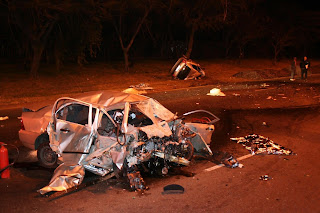Every year we get news reports updated almost daily of the numbers killed on our roads in South Africa over the festive seasons (usually April and December). This morning's figure stood at 840 deaths since the beginning of December. This has the ability to dampen the mood of the Christmas season as I think about how many people will be experiencing unexpected sadness instead of the joy that Christmas is supposed to bring. This always brings to my mind a few questions / things to think about.
Firstly, this is a large number, and is horrific, but how does it compare to the rest of the world in eg. deaths per 100 000 population? I have no idea. Ours is 21.96 per 100 000. We have a population of officially about 45 million (but probably more) of which I would estimate at most only about 2 to 3 million (but probably less) own a car and drive.
Secondly, how many people are injured non-fatally? This I'm sure would be an even scarier statistic!
Thirdly, how do these months of the year compare to the rest? Working in a hospital one is definately aware of the increase in workload, especially assault cases, that go with any public holiday / festivity / end-of-the-month-weekend, as a direct result of alcohol consumption, and therefore most of us try our utmost to avoid these shifts! But if I think about it, the number of motor vehicle accidents are much the same as at any other time of year. I have never seen any statistics, and could not find any at the department of transport, for deaths on the roads "out of season". I did find some figures from the Arrive Alive website which showed 14463 fatal accidents in 2008, which if you divide by 12, suggests there are a little over 1200 fatal accidents on our roads every month. This would suggest that this festive season is better than the rest or the year!
Forthly, alcohol is a major causative factor in road accidents, but I believe not in the way everone thinks it is. It is always reported in the media how many drunk drivers have been caught / arrested / fined. I think they are missing the mark. I think the traffic department is using statistics from other parts of the world and wrongly applying it to our situation. The vast majority of road accident victims I have seen when on duty in South Africa have been drunk pedestrians - knocked down by sober drivers. I believe it is here that the bigger problem lies. The traffic police / Arrive Alive campaigns are focusing on the wrong area. Yes, I agree drinking and driving is a big problem, but drinking and walking is a far bigger problem! The only forensic blood alcohol level tests I have had to do in A&E have been on drivers involved in minor bumper-bashings. Maybe this is just my experience.
I can think of a few reasons other than drunk driving that are also significant causes for the carnage on our roads.
The majority of our population use public transport, of which the majority is probably unroadworthy, and usually drastically overloaded. It is not uncommon to see a bus moving in a way I like to describe as "crab-like", where the rear wheels do not line up with the front wheels, and minibus taxi's designed to carry 16 people, carrying 30 or more. When one of these crashed in my hospital's area, there were often reports of up to 10 dead in one accident!
Deteriorating roads is another cause of concern. Generally, our roads are still in good shape, but over the past 10 years I have noticed an ever increasing rate of decline in the state of our roads. They get repaired, but the repairs don't seem to last very long. I am sure this is and will become more and more important.
Fifthly, today is the 28th of December. A lot of the people travelling the roads of our country are those migrant labourers working in Gauteng, but who all go home to their families in Mozambique, Zimbabwe, and the Eastern Cape for Christmas. If 840 of them died going home, how many will die coming back to work / back form holiday in the new year? This will be in January, and will not be reported in the statistics.
I suppose what I'm trying to get at is, to avoid becoming a statistic, we all should drive carefully, no matter what time of year, make sure our vehicles are roadworthy before we leave, pick the best roads, avoid the busy times, and don't drink and drive.













